Who lived where in Sawbridgeworth in 1911
Who lived where in Sawbridgworth in 1911.
by Hilary Matthews and Theo van de Bilt
The 1911 census was undertaken in April of that year. It is often referred to as the fertility census. The reason for that being that at the time eugenics had become very popular. This science or perhaps we should say pseudoscience is defined by the desire to improve a population by controlled breeding and to increase the occurrence of desirable heritable characteristics. Many politicians had become convinced that the “wrong people” had too many children whilst the “right people” did not have enough. Registrar General Bernard Mallett, the man overseeing the 1911 census would go on to become president of the Eugenics Society. Later on the movement became discredited as it was associated with Nazi Germany and the Holocaust.
Looking at the census form people were asked to fill in you do indeed notice columns where residents had to fill in the number of children born alive, those that were still living and those that had died.
A spreadsheet which we prepared from that 1911 census contains details of 532 Sawbridgeworth households, with all in all 2198 people. The average dwelling had 4.2 occupants and contained 5.4 rooms. There were also 0.29 lodgers per household and 0.24 servants. But averages do not reflect reality of course. On one extreme there was Arthur, the 7th Earl of Arrran who lived at the 19 room Hyde Hall with his wife and two sons and was being looked after by 15 staff. At the other end of the scale there was William Cooper of Spelbrook, a “peat merchant” who with his wife and three young children lived in a “dwelling van”, a mobile home we would say nowadays. Needless to say the Coopers did not have any servants!
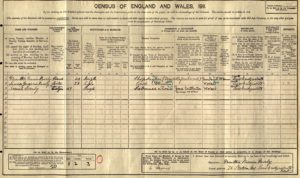
A sample 1911 census form: the Paveley family of Hand Terrace. Sons Fred and Herbert later on perished in World War 1.
There were two other grand houses in Sawbridgeworth. Francis Charrington, director of the brewery of the same name and a retired colonel lived in Pishiobury Park with his wife and 4 children. The Charringtons were a wealthy family and had 14 servants looking after them. At Rowneybury, where recently David and Victoria Beckham lived for a while, Robert Cooper resided with his wife and son plus 5 servants. Cooper was a stockbroker.
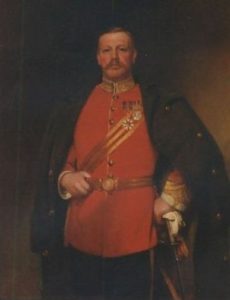
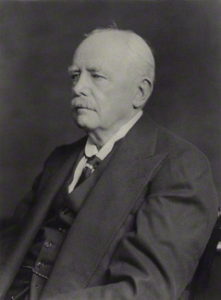
Two Sawbridgeworth residents and former soldiers- On the left Francis Charrington, later a brewer, with his campaign medals – On the right Arthur Arran Viscount Sudley.
An ordinary Sawbridgeworth person of today looking at our spreadsheet will of course immediately start looking at family names possibly his or her own, so below we are listing a number of names that commonly occurred and the frequency with which they occurred.

Children: The average head of household was 47 years old and had 2.2 children; there had been 2.4 live births. Once again of course averages do not tell the story. Charles Dyer, master butcher of Knight Street had 12 children, whilst 102 households had 5 or more children, 189 had no children listed. There is no question however that many less well off people had a lot of children.
In a separate column people were asked to list their professional status. This was the profession of the head of household, predominantly male. The great majority of those (308) simply said they were “workers”, 62 people said they were employers, 41 were OAPs, retired or pensioner. Fifty eight people listed “own account”, the great majority of these were tradesmen of one sort or another: publicans, shopkeepers, dressmakers and boarding house keepers. A final 37 mentioned “private means”. Whether these were indeed wealthy people should perhaps be doubted. Only 13 of these had live in servants and 5 of the remaining 13 had only 1 servant.
Occupations: As can be expected in our area at that time, most people worked on the land in one way or another. Forty four heads of household said they were somehow involved in farming, 18 mentioned gardening and 39 nursery work. Thirty nine heads of household worked in the malting industry whilst 11 called themselves publicans, licensed victuallers or beer retailers. The other “industry” worth naming is building in its widest sense with 16 bricklayers or journeyman bricklayers and similarly 10 carpenters and journeyman carpenters, 10 house painters and 4 general builders. Finally we could mention 7 shopkeepers. These figures should not be taken too strictly as people described their jobs in a baffling variety of ways.
Much like today the central business district of Sawbridgeworth was concentrated around the square of Station Road, London Road, Bell Street (in particular) and Knight Street. It can also be said that the population of Sawbridgeworth were well catered for with a larger selection of shops, many more than today. Residents could shop for nearly everything without having to go out of town. This was very important because there were scant resources for travelling any distance and very few households had their own means of transport. Those employed in nearby towns and villages most probably walked or cycled there; some may have used the railways.
Apart from pubs / beer retailers the 1911 Census then mentions:- 13 people working for GER (the railways), a post Office employing a clerk and 3 post men and a police station with a sergeant and a PC. There were 5 dress makers, 5 Master butchers, 5 laundresses / washerwomen, 6 shoe smiths / boot makers / shoe repairer/shoe sellers, 9 grocers/ green grocers, and 5 bakers/confectioners. Other professions mentioned but which we may not be so familiar with nowadays were wheel wrights, harness makers, saddlers, haberdashers, basket makers, ironmongers and a furrier. Once again it should be emphasised that the occupations mentioned were those of the heads of household. If married women took in washing, were engaged in dressmaking or helped out on the fields for example, that was not mentioned. Some people listed more than one occupation such as the above mentioned shoemakers/etc or bakers/confectioners. One person even combined being a grocer and a draper!
There were a number of boarding houses and there were many people who took in lodgers. The great majority of these had only one lodger; it provided some extra income for some very poor people. Of the 64 households with 1 lodger most did not have servants two had 2 servants, 4 had just 1. At the boarding houses themselves there was not much luxury either. At 14 Springhall Road, Mrs. Mary Ann Prior, a 65 year old widow had 6 rooms in her house and kept 4 lodgers. She had no servants to help her. Boarders also provided company of course. Perhaps that is why Mr. George Foster stayed on at the King of Prussia for so long. See below for a little snippet from the Walsall advertiser.

Apart from the census forms themselves there were other documents to draw information from: the enumeration summary books. There were two, one for each of the areas, numbers 9 and 10. Book 9 listed the forms collected by Sidney Parfect, book 10 those collected by William Morris. Parfect, 32 at the time, was head teacher of the Fawbert & Barnard Elementary School, an interesting figure who perhaps should be written about separately. William Morris was a Sawbridgeworth native of 44 and clerk to both Sawbridgeworth Urban District Council and High Wych Parish Council. Both of which had been established 10 years previously. Both Parfect and Morris were obviously pillars of local society!
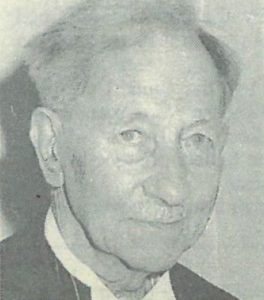
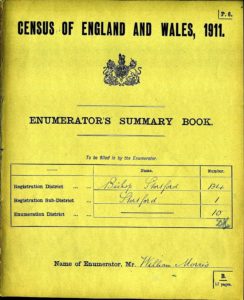
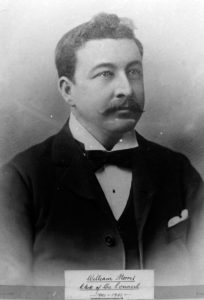
Sidney Parfect Summary Book 10 William Morris
Recently converted from a rural parish into an urban district Sawbridgeworth in 1911 was a self contained community where most people worked locally and often had a connection to the land. Only three years later the Great War would break through that relative isolation and change local life forever.
Sources used were Ancestry co.uk, Wikipedia and Tracing your Ancestry using the census, a 2013 publication by Emma Jolly.